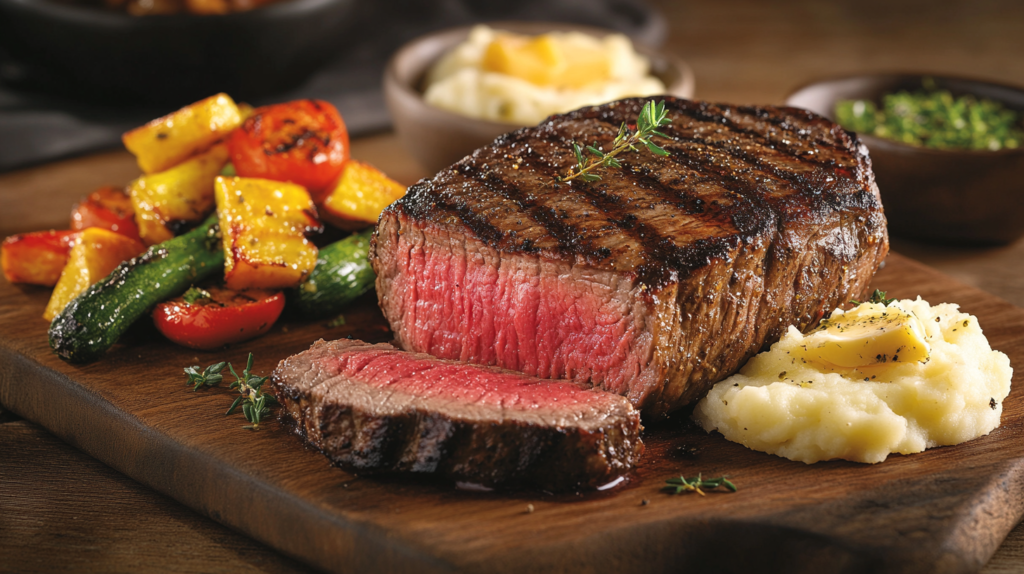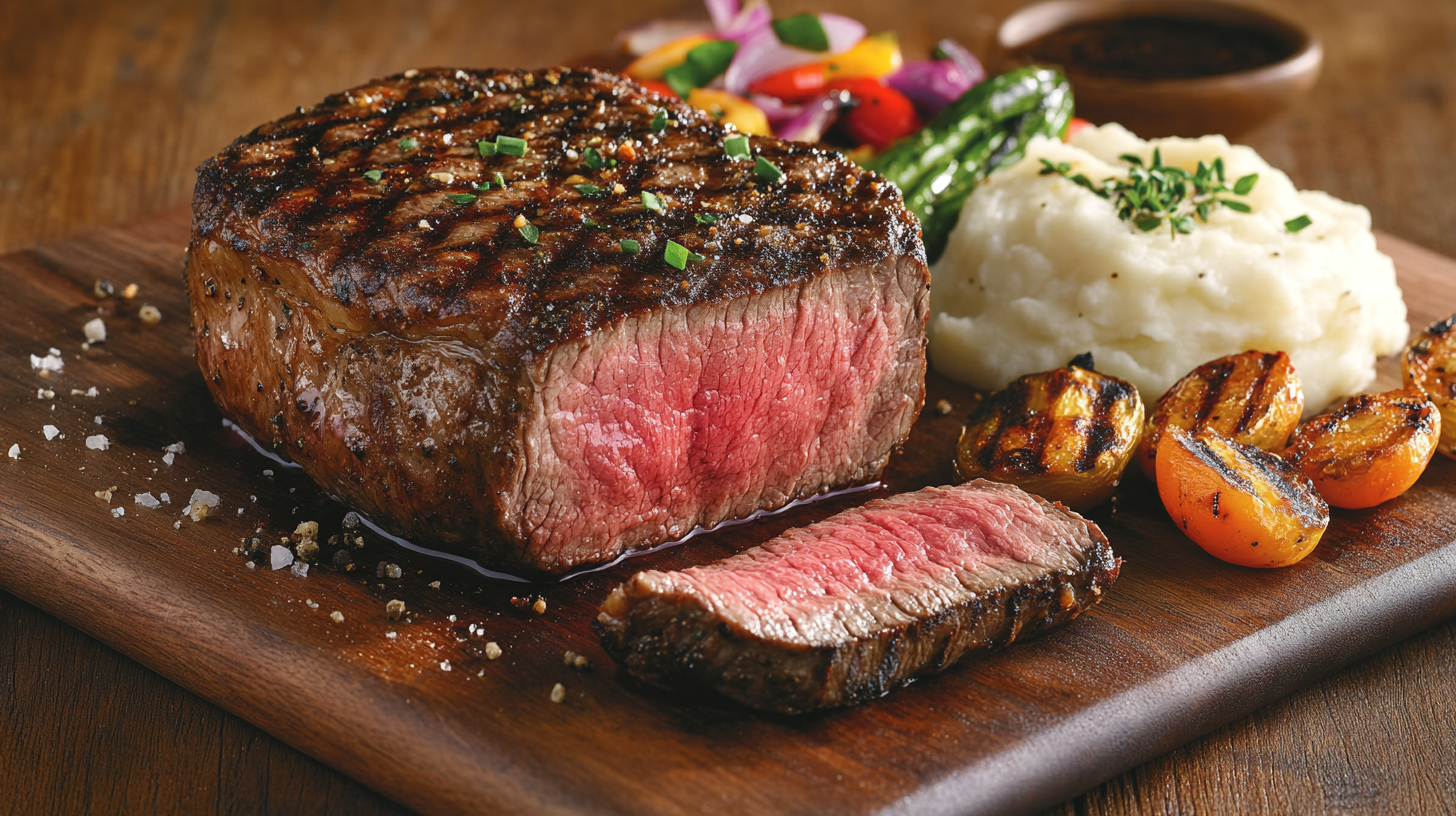How to Cook Chuck Eye Steak: The Ultimate Guide
Who doesn’t love a juicy, perfectly cooked steak? If you’re tired of spending a fortune on ribeye but don’t want to sacrifice flavor, let me introduce you to the star of the show: chuck eye steak. Often called the “poor man’s ribeye,” this hidden gem is flavorful, affordable, and easy to cook — if you know the tricks. So, let’s dive into this guide and learn how to cook chuck eye steak like a pro!
What is Chuck Eye Steak?
Before we get cooking, let’s start with the basics. Chuck eye steak is cut from the shoulder area of the cow, known as the “chuck primal.” It’s located right next to the ribeye section, which is why it shares some of the same incredible marbling and flavor. Think of it as ribeye’s younger sibling — similar, but not quite as tender.
The Origin and Cut of Chuck Eye Steak
The chuck primal is the shoulder region, which works harder than the rib section. As a result, the meat here isn’t as naturally tender as ribeye. However, the first few cuts from this section, called chuck eye, are an exception. They’re packed with marbling, which gives them their signature rich, beefy flavor.
Chuck Eye Steak vs. Ribeye: Key Differences
Let’s get one thing straight: chuck eye isn’t ribeye. While they look similar, chuck eye steak has a slightly tougher texture. But don’t worry — with the right cooking techniques, you can bring out its full potential. The best part? Chuck eye costs significantly less, making it a great alternative for steak lovers on a budget.
Why Choose Chuck Eye Steak?
Still not convinced? Let me tell you why chuck eye steak deserves a spot on your plate.
Flavor Profile and Texture
If you’re all about bold, beefy flavors, chuck eye steak is a dream come true. Its marbling adds a buttery richness that melts in your mouth, while its slightly firmer texture gives it a satisfying bite. It’s the kind of steak that feels indulgent without being overly fatty.
“Chuck eye steak is like the best-kept secret of the steak world — affordable, versatile, and oh-so-delicious.”
Affordability and Versatility
Let’s face it: ribeye is amazing, but it can drain your wallet pretty quickly. Chuck eye steak, on the other hand, offers similar satisfaction at a fraction of the price. Plus, it’s incredibly versatile. Whether you’re grilling, pan-searing, or slow-cooking, chuck eye steak adapts beautifully to different cooking styles.
Preparing Your Chuck Eye Steak
Cooking a great steak starts long before you turn on the stove. Preparation is key to unlocking chuck eye steak’s full potential.
How to Select the Best Chuck Eye Steak
Not all chuck eye steaks are created equal, so it’s important to choose wisely. Look for steaks with a deep red color and plenty of marbling (those white streaks of fat). The marbling is what gives the steak its juicy, tender texture, so don’t skimp on this!
Proper Thawing and Trimming Techniques
If your steak is frozen, thaw it in the fridge overnight. Avoid the microwave, as it can partially cook the meat and ruin the texture. Once thawed, trim any excess fat from the edges, but leave some for flavor.
Prepping the Steak: Marinades and Rubs
Now comes the fun part: flavoring your steak! You can keep it simple with salt and pepper or go bold with a marinade or dry rub. Here’s a quick marinade recipe to try:
Zesty Garlic Marinade
Mix olive oil, minced garlic, soy sauce, lemon juice, and a pinch of red pepper flakes. Let your steak soak up the flavors for at least an hour, or overnight for maximum impact.
Marinades not only enhance flavor but also help tenderize the meat, making it even more delicious.
Cooking Methods for Chuck Eye Steak
There’s no one-size-fits-all approach to cooking chuck eye steak. It all depends on your personal taste and available tools. Let’s explore a few popular methods.
Grilling Chuck Eye Steak for Maximum Flavor
If you love smoky, charred flavors, grilling is the way to go. Preheat your grill to medium-high heat, season your steak, and cook it for about 4-5 minutes per side for medium-rare. Use a meat thermometer to check the internal temperature (130°F for medium-rare).
Pan-Seared Chuck Eye Steak
No grill? No problem. Pan-searing is a quick and easy way to cook chuck eye steak indoors. Heat a cast-iron skillet over high heat, add a drizzle of oil, and sear your steak for 3-4 minutes on each side. Don’t forget to baste it with butter and herbs for that extra layer of flavor.
Using Sous Vide for Precise Results
Feeling fancy? Sous vide is the ultimate way to ensure your steak is cooked evenly. Seal your steak in a vacuum bag, cook it in a water bath at 130°F for 1-2 hours, and then give it a quick sear in a hot skillet for a perfect crust.
Cooking Tips for the Perfect Chuck Eye Steak
Want to take your steak game to the next level? Here are some tips to help you cook the perfect chuck eye steak every time.
Achieving the Perfect Sear
The secret to a perfect sear is high heat and a dry surface. Pat your steak dry with a paper towel before seasoning, and make sure your grill or skillet is hot enough to create that beautiful crust.
How to Avoid Overcooking
Nobody likes a dry steak, so keep an eye on the internal temperature. A meat thermometer is your best friend here. Aim for 130°F for medium-rare, 140°F for medium, and so on.
“Think of cooking steak like a dance — timing and precision are everything!”
Resting Your Steak for Maximum Juiciness
This step is non-negotiable. After cooking, let your steak rest for 5-10 minutes before slicing. This allows the juices to redistribute, ensuring every bite is tender and flavorful
Common Mistakes When Cooking Chuck Eye Steak
Even seasoned cooks can run into problems when cooking chuck eye steak. Let’s tackle some common mistakes so you can avoid them and enjoy a perfect steak every time.
Overcooking and How to Prevent It
One of the most common mistakes is overcooking. Chuck eye steak, like any cut, becomes tough and dry when cooked too long. To avoid this, always use a meat thermometer. Remember, medium-rare is the sweet spot for chuck eye steak, with an internal temperature of 130°F. If you’re grilling or pan-searing, pull it off the heat a few degrees early since it continues cooking as it rests.
Using Too Little Seasoning
Under-seasoning is a rookie mistake. Chuck eye steak has a bold flavor, but it still needs a little help to shine. Don’t be afraid to go heavy on the salt and pepper or experiment with a robust dry rub. The seasoning creates a delicious crust that enhances the steak’s natural flavorsH3: Skipping the Resting Step
Patience pays off, especially when it comes to steak. Cutting into your chuck eye steak right after cooking releases all the juices, leaving it dry. Always let it rest for at least 5-10 minutes before slicing. Think of it as letting your steak “catch its breath” before serving.
Flavor Pairings for Chuck Eye Steak
To make your chuck eye steak meal unforgettable, pair it with sides, sauces, and drinks that complement its rich flavor.
Best Side Dishes to Serve with Chuck Eye Steak
A great steak deserves great sides. Here are a few classics to consider:
- Garlic Mashed Potatoes: Creamy and buttery, with a hint of roasted garlic, this side is a match made in heaven.
- Roasted Brussels Sprouts: Tossed in olive oil and sea salt, these crispy veggies add a fresh contrast to the steak’s richness.
- Sweet Potato Fries: Their caramelized sweetness balances the steak’s savory flavor.
Perfect Sauce and Garnish Options
A good sauce can take your chuck eye steak to the next level. Here are some ideas:
- Chimichurri: A tangy, herby sauce that brightens up the beefy flavor.
- Garlic Herb Butter: Melt it on top of the steak for an indulgent finishing touch.
- Red Wine Reduction: Fancy, yes, but surprisingly easy to make at home.
“A drizzle of chimichurri or a dollop of garlic butter is like the cherry on top of your steak sundae!”
Wine and Beverage Pairings
Pair your chuck eye steak with a drink that enhances its flavors. Here are some great options:
- Red Wine: A Cabernet Sauvignon or Malbec complements the steak’s richness beautifully.
- Craft Beer: A brown ale or stout adds malty, roasted notes that pair well with grilled steak.
- Sparkling Water with Lemon: For a non-alcoholic option, this is refreshing and palate-cleansing.
Chuck Eye Steak Recipes You Must Try
Ready to get cooking? Here are three tried-and-true recipes that showcase the versatility of chuck eye steak.
Classic Grilled Chuck Eye with Herb Butter
This recipe keeps it simple, letting the natural flavors of the steak shine.
Ingredients:
- 2 chuck eye steaks
- Salt and pepper
- 2 tbsp butter
- 1 clove garlic, minced
- 1 tbsp fresh parsley, chopped
Instructions:
- Season the steaks generously with salt and pepper.
- Preheat your grill to medium-high heat.
- Grill the steaks for 4-5 minutes per side for medium-rare.
- While the steaks are resting, melt the butter and mix in the garlic and parsley.
- Drizzle the herb butter over the steaks and serve.
Pan-Seared Chuck Eye with Garlic and Thyme
Perfect for a quick yet elegant dinner.
Ingredients:
- 2 chuck eye steaks
- Salt and pepper
- 2 tbsp olive oil
- 3 cloves garlic, smashed
- 2 sprigs fresh thyme
Instructions:
- Heat olive oil in a cast-iron skillet over high heat.
- Season the steaks with salt and pepper, then sear for 3-4 minutes on each side.
- Add garlic and thyme to the skillet, and spoon the infused oil over the steaks while they finish cooking.
- Rest the steaks for 5 minutes before serving.
H3: Chuck Eye Steak Tacos for a Creative Twist
Who says steak has to be served with a fork and knife? These tacos are a fun, flavorful way to enjoy chuck eye steak.
Ingredients:
- 1 chuck eye steak
- 1 tbsp taco seasoning
- 1 tbsp olive oil
- 8 small tortillas
- Toppings: avocado slices, salsa, shredded cheese, fresh cilantro
Instructions:
- Rub the steak with taco seasoning and olive oil.
- Heat a skillet over medium-high heat and cook the steak for 3-4 minutes on each side.
- Rest the steak for 5 minutes, then slice it thinly.
- Assemble the tacos with your favorite toppings.
“Chuck eye steak tacos are like a fiesta on your plate — bold, fun, and oh-so-satisfying!” 🌮

Storing and Reheating Chuck Eye Steak
Got leftovers? Lucky you! Here’s how to store and reheat them while keeping the flavor intact.
How to Store Leftover Steak Properly
Wrap your steak tightly in aluminum foil or store it in an airtight container. Place it in the fridge, where it’ll stay good for up to 3 days. For longer storage, freeze it in a freezer-safe bag for up to 3 months.
Reheating Techniques to Keep Steak Juicy
When reheating steak, the goal is to warm it up without drying it out. Here are some methods:
- Oven: Wrap the steak in foil and heat it in a 250°F oven until warmed through.
- Stovetop: Add a splash of beef broth or water to a skillet, cover it with a lid, and heat on low.
- Sous Vide: If you have the equipment, this is the best way to reheat steak evenly.
Frequently Asked Questions About Chuck Eye Steak
Let’s address some of the most common questions people have about cooking chuck eye steak.
Is Chuck Eye Steak Good for Beginners?
Absolutely! Chuck eye steak is forgiving and easy to cook, making it perfect for beginners. With a few simple techniques, you’ll look like a pro.
How Tender is Chuck Eye Steak Compared to Ribeye?
While chuck eye steak isn’t as tender as ribeye, it’s still wonderfully juicy and flavorful. The key is proper cooking and resting.
Conclusion: Why Chuck Eye Steak is Worth Trying
Chuck eye steak proves that you don’t need to spend a fortune to enjoy a delicious steak dinner. With its bold flavor, versatility, and affordability, it’s the perfect cut for home cooks who want the best of both worlds. So go ahead, grab a chuck eye steak, and treat yourself to a restaurant-quality meal at home. You’ve got this! 🥩✨
Let me know if you’d like additional sections, revisions, or further assistance! 😊
How to Cook Chuck Eye Steak Like a Pro
Are you looking for a flavorful steak that doesn’t break the bank? Enter the chuck eye steak. Known as the “poor man’s ribeye,” this affordable cut packs a punch of flavor and is incredibly versatile. Let’s explore how to cook chuck eye steak perfectly, with tips, recipes, and flavor pairings.
What is Chuck Eye Steak?
Chuck eye steak is a hidden gem among beef cuts. Sourced from the shoulder (or chuck primal), it’s the closest neighbor to the ribeye, sharing its marbling and rich taste.
If you’re curious about how chuck eye compares to other popular steaks, check out this detailed guide on Delmonico steak for more insights into beef cuts.
Preparing Your Chuck Eye Steak
Preparation is key to getting the most out of your chuck eye steak. Selecting the right cut, seasoning it generously, and using the right techniques will make all the difference.
How to Choose the Right Cut
The best chuck eye steak has visible marbling (white streaks of fat) and a bright red hue. These traits ensure tenderness and flavor.
For a deeper dive into steak selection, read this resource on how to cook Delmonico steak perfectly — many of the tips apply to chuck eye as well!
Cooking Methods for Chuck Eye Steak
There are several ways to cook chuck eye steak, and each method has its own benefits. Whether you’re grilling, pan-searing, or slow-cooking, chuck eye steak adapts beautifully.
Grilling Chuck Eye Steak
Grilling brings out the natural smokiness of the meat. Preheat your grill to medium-high heat, season your steak with salt and pepper, and cook for about 4-5 minutes on each side. Let it rest for 5 minutes to lock in the juices.
Pairing Chuck Eye Steak with Sides
Pairing your steak with the right sides enhances its flavor. Here are some ideas:
- Mashed Potatoes: Creamy and buttery, they balance the steak’s richness.
- Roasted Vegetables: Add freshness and crunch to your meal.
If you’re into creative sides, check out this pizza rustica recipe for a unique pairing idea.
Reheating and Leftover Tips
Steak leftovers? Lucky you! Properly reheating chuck eye steak can be a challenge, but it’s easy if you follow these tips:
- Oven Method: Wrap the steak in foil and heat at 250°F until warm.
- Stovetop: Add a splash of broth and cover with a lid for juicy results.
For more leftover inspiration, you might also enjoy this guide to chicken salad recipes, which features easy meal-prep ideas.

